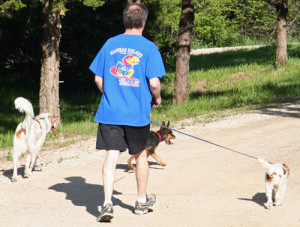We are convinced there two principle ingredients to improved health: eating better and being more active.
There are many ways to be more active. I will discuss the benefits of a regular exercise program in future habits but I started with just walking more. Gradually, over time I have returned to jogging, but I started with walking.
Heading out for a walk with the dogs
I walk every day, twice a day, with our two dogs: Bingley and Bear. We walk no matter what the weather (ok, if the wind chills is -30, we shorten it a bit but we still go). We walk a mile in the morning and another mile about supper time. It does them good and it does me good. Another way I walk regularly is by parking about 7 minutes from my office (where parking on the street is available) rather than in the parking garage across the street. It saves me the $60/month for parking and gives me a bit more walking time.
In addition to improving health, walking gives me time to pray, unwind from a busy day, give consideration to some matter that needs some time away from other distractions, or listening to a book on tape (in my case via Audible).


